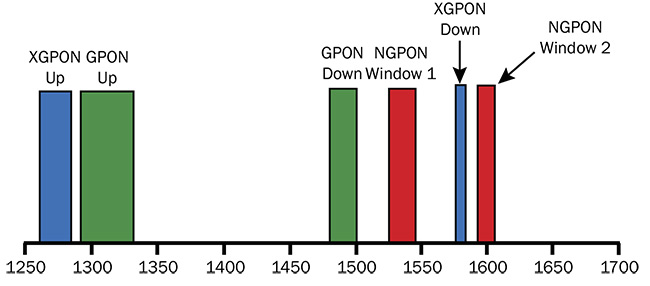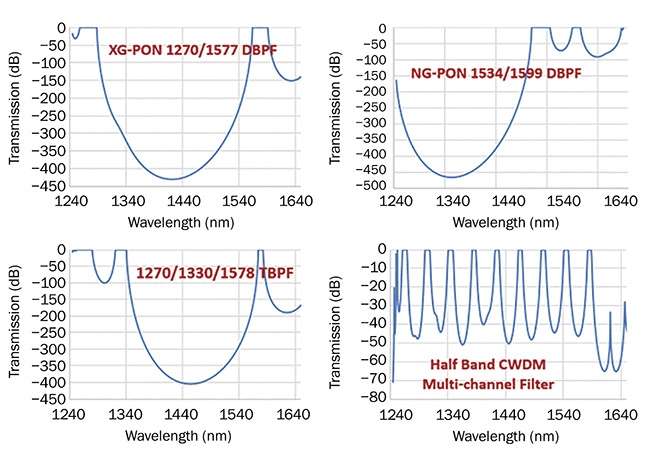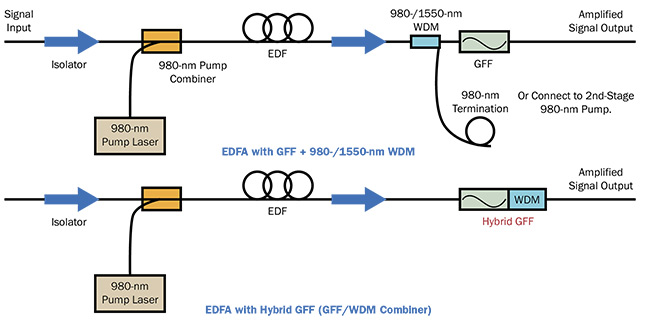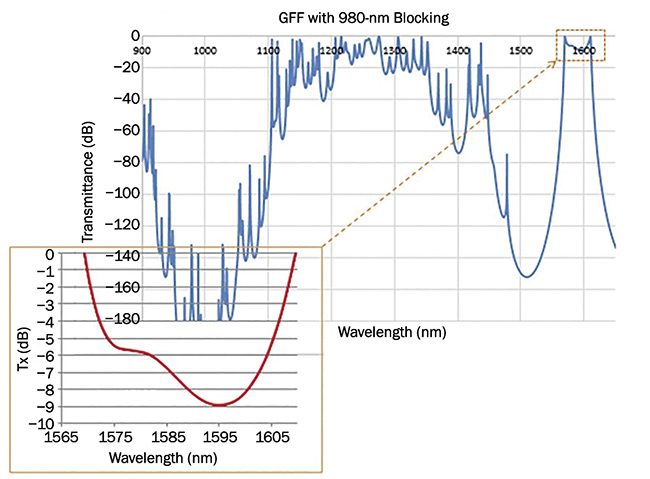Full company details
Iridian Spectral Technologies
Div. of IDEX Optical Technologies
 2700 Swansea Crescent
2700 Swansea Crescent
Ottawa, ON K1G 6R8
Canada
Phone: +1 613-741-4513
Fax: +1 613-741-9986
Multiband Optical Filters Are Telecom Networks' Multitaskers
Photonics Spectra
Mar 2021Dual- and multiband optical filters are helping to enhance the complexity, footprint, performance, and cost of fiber network components.REBECCA SAALTINK AND XIAOLUN ZENG, IRIDIAN SPECTRAL TECHNOLOGIES
Multiband optical filters have long been used in applications such as fluorescence spectroscopy, astronomy, and 3D cinema, to name a few. The ability to combine more than one spectral band into a single optical filter can enable flexibility of system design and reduce the number of components and the costs needed to achieve a desired functionality.

Courtesy of Iridian Spectral Technologies.
Optical filters have always played a key role in fiber optic telecom systems. They provide the wavelength selectivity needed for optical add-drop module (OADM)
and wavelength division multiplexing (WDM) functions, and tailored loss profiles to enable gain-flattening filters (GFFs) in erbium-doped fiber amplifier (EDFA) modules.
Recent advancements in multiband and multifunction optical filters have expanded the benefits to telecom components. Such filters not only supported the development of dual- and multibandpass filters for use in the backbone WDM architectures associated with wireless networks, they also enabled hybrid GFFs that couple gain-flattening functionality with laser pump blocking. These component advancements leverage the power of multiband filters to improve performance and save module build costs.

Wavelength division multiplexing passive optical network (WDM PON) wavelength bands. G: gigabit; NG: next-generation; XG: 10G. Courtesy of Iridian Spectral Technologies.
Didn’t WDM solve this?
WDM technology has been around since the late 1990s, when it emerged from and enabled the massive growth in demand for greater telecommunications bandwidth to support the World Wide Web. By using thin-film filters, module and system architects could optically
add or drop individual channels in a single fiber. Coarse WDM (CWDM) (with 20-nm band spacing) was followed by dense WDM (DWDM), which offered subnanometer band spacing to transport multiple-signal bands simultaneously along the fiber optic highway.
The thin-film filters at the time consisted of single-band WDM channels
that transmitted or reflected a single-signal channel, or sometimes a group of channels using an X-skip-Y OADM skip filter.
Daisy-chaining individual bands or
groups of bands sequentially also achieves
the goals of WDM, but with several drawbacks, including requiring the use of one filter component per band, which imposes a financial cost to build more components. It also increases a module’s footprint, as well as insertion losses on individual channels. Note that these losses are often what prompt the skip filter approach.
In 2008, Iridian’s collaboration with a wireless communications system designer led to the recognition that combining two bandpass filters onto a single filter chip could provide valuable benefits to a wireless base station interconnect module. The market needed technologies to enable and improve the performance and cost of 4G LTE wireless transmission systems.

Examples of multiband optical filter curves — such as XGPON, NGPON, triple band, and CWDM (coarse
wavelength division multiplexing) multiband — in a passive optical network. DBPF: dual-bandpass filter;
TBPF: triple-bandpass filter. Courtesy of Iridian Spectral Technologies.
By employing the dual-band filter design, a single filter chip could permit passbands at both 1310 nm (data upstream) and 1490 nm (data downstream) to circumvent the need to use two single-bandpass filters with the same individual passbands.
This capability revolutionized WDM and passive optical network (PON) design by simplifying connections, conserving space within the module, and eliminating costs associated with sourcing and implementing numerous single-band filters.
Today, the technological demands of 5G wireless networks and the Internet of Things promise to drive demand for bandwidth higher, making low-cost modules based on multiband filters more critical than ever.

A schematic of a traditional erbium-doped fiber amplifier (EDFA) system employing components of both a gain-flattening filter (GFF) and an optical add-drop module (OADM), versus a system with a single hybrid GFF. Courtesy of Iridian Spectral Technologies.
Currently, the most common telecom application for multiband filters is wireless station interconnects for 4G, 4G LTE, and 5G systems. These filters can also benefit CWDM systems by minimizing component count and footprint in passive optical networks (e.g., GPON, XGPON, and XGSPON) that, when employed in fiber-to-the-home networks, leverage three specific signal band channels: 1310, 1490, and 1550 nm; or data upstream, data downstream, and video downstream, respectively.
Multiband apps multiply
The advent of all-optical passive EDFA modules revolutionized telecom networks. The modules eliminated the need for the optical-to-electrical-to-optical signal transfer previously required for electronic amplification. Instead, EDFAs allowed amplification of an optical band (potentially carrying many multiplexed signals) within a segment of erbium-doped fiber. Lasers operating at 980 or 1480 nm would excite the erbium atoms, which would then emit large numbers
of photons at the same wavelengths as
an incoming signal.
The gain produced by EDFAs is inherently wavelength dependent, and subtle differences in their doping levels can also cause variability in their gain profiles. These differences necessitated the introduction of thin-film-based GFFs into EDFA modules to ensure all signals achieved the same level of amplification, independently of wavelength.
GFFs typically operated in tandem with a thin-film optical add-drop module (OADM) filter that blocked 980- or
1480-nm signals to avoid interference between the pump laser and telecom’s
C- and L-band signals — 1520 to 1570 nm for the C-band and 1570 to 1620 nm for the L-band, respectively.
Recently, hybrid GFFs have built on this conventional thin-film multiband
approach for OADM to offer a new solution that combines OADM and GFF
function in one component — a multi-band, or, perhaps more accurately, a multifunction GFF.
These hybrid GFFs block the pump laser at either 980 or 1480 nm while
gain-flattening the signal light amplification in the C- and L-bands. This approach forgoes the need for an additional blocking filter for the pump wavelength. While this is the most common configuration for hybrid GFFs, they can be designed to pass or block wavelengths anywhere within the 900- to 1700-nm wavelength region. The freedom of design allows these components to meet multiple needs of the optical module designer.
As with WDM multiband filters, the most obvious benefit of hybrid GFFs is their cost, which, while comparable to a standard GFF, offers the functionality
of two components. In addition to eliminating the cost of a separate WDM, use of a hybrid GFF reduces system-level complexity.
In terms of quantifiable performance metrics, hybrid GFFs offer little penalty compared to standard GFFs. There is no compromise, for example, in the peak-to-peak error function between a standard and hybrid GFF.
Integration advantages
Thin-film bandpass filters, whether designed as a WDM or GFF, must be packaged before they can be integrated into a system or module. The package consists of the filter itself, two collimating lenses, and fiber couplings. If using two or more single-bandpass filters within a module, designers must plan space to connect all fiber-based components to one another, allowing room for the components themselves and all fiber routings as well.
By employing dual- or triple-band filters, optical designers can eliminate at least one or two fiber connections. This reduction in components and fiber routing reduces the overall footprint for the equipment closets in which wireless interconnect stations are installed. This feature will become more critical as the rollout of 5G networks calls for more stations, which often occupy costly urban real estate. Streamlining the components in these closets can also reduce costs associated with maintenance, as well as operations such as cooling and power.

A spectral trace of a hybrid GFF demonstrating both 980-nm blocking and C-band gain flattening. Courtesy of Iridian Spectral Technologies.
The maximum band density (i.e., the maximum number of filters/bands packaged into one component) depends on customer specifications. Suppliers such as Iridian Spectral Technologies have achieved as many as nine bands between 1240 and 1650 nm. This suggests that the only practical limit on how many bands can fit is how steep each band needs to be. A reasonable channel spacing must be maintained to ensure that dead bands — those between high-transmission and high-reflection regions — are not too steep. For example, while 20 nm is an achievable band space, 50 or 60 nm between adjacent passbands is preferable. Additional bands do not inherently suffer from performance degradation. On the contrary, multibandpass filters are capable of producing a flat passband and good reflectance isolation in almost all use cases. Nonetheless, dual- or triple-band filters are the most typical configurations used in the telecommunications wavelength range.
In both WDM and GFF applications, multiband filters achieve the same the design goals: simplified design, a smaller footprint, and improved system performance. All of these advantages stem from the reduction in components and fiber connections.
Further, the cost of using multiple single-bandpass filters does not scale linearly with the number of bands. Cost is primarily driven by the steepness needed to fit within the allowed dead bands. This determines the thickness and complexity of the filter design. More complex filters require longer deposition times and make it harder to achieve high yields. A design with 5-nm dead bands is going to be more expensive than a design with 10-nm dead bands.
Assuming a single- and a dual-band filter share similar dead band specifications — in particular, for steepness — the total cost should be comparable. As a rough guideline, a multibandpass filter will be priced about 20% higher than its single-band counterpart, despite doubling the single-band component’s capability and offering improved performance and fit. Note that this is a general guideline and will vary, subject to specific application needs and their associated specifications.
The telecommunications industry is a uniquely ruthless technological environment. It presents continually evolving technical and commercial challenges to meet ever-present demands for more data and lower costs.
Multiband optical filters can offer a customizable means to enable module and systems designers and manufacturers to optimize the price-performance balance of their products, and this particularly
applies to WDM and PON modules as well as EDFAs. Multiband optical filters can help conserve space, simplify design, and offer comparable or better performance versus single-band filters, often at little additional cost. With multiband filters, 1 + 1 > 2.
Meet the authors
Xiaolun Zeng is product group manager for telecom optical filters at Iridian Spectral
Technologies and has more than 20 years of experience and expertise with fiber optic telecom applications, systems, and components.
Rebecca joined Iridian Spectral Technologies as an Applications Engineer specializing in telecom filter design with a focus on continued improvement of DWDM filter performance.